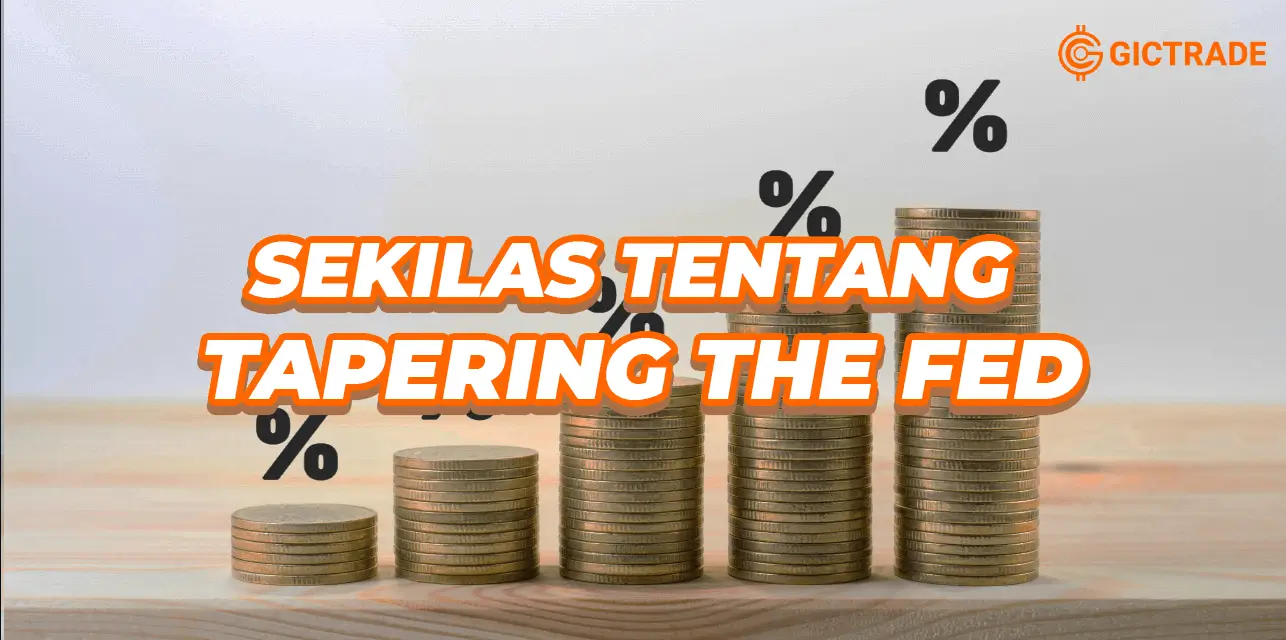What is Tapering Off the Fed?
Tapering off the Fed is a term Fed officials (and others) use to describe plans to phase out their moves, by cutting back on bond purchases over an extended period. The hope is to slowly wean the economy from the extra stimulus that purchases are given to avoid an emergency landing. The Fed has been buying $120 billion in bonds per month. The plan, announced on Nov. 3, calls for it to fall by $15 billion a month starting in November. Taper refers to a post-crisis asset purchase plan, in which the Fed, at a predetermined pace, begins slowly and gradually reducing how many assets it buys each month (the process of buying securities for stimulative purposes is commonly called quantitative easing, or QE for short). In today's case, the Fed currently buys $80 billion worth of Treasury securities and $40 billion in mortgage-backed bonds every month, the largest asset-buying program in the Fed's history that illustrates the severity of the recession caused by the pandemic. The Fed buys those assets on the open market and then adds them to the balance sheet, which has ballooned to more than $8 trillion since the pandemic. When the Fed finally decided that it was time to taper those purchases, it wasn't the first time it did. After the 2008 financial crisis, the Fed in December 2013 began reducing purchases of mortgage-backed securities and the Treasury by a cumulative $10 billion each month. The process ended 10 months later, when the purchase reached zero. "The precedent is that they rolled back their stimulus at the stated pace, and they complied with it," said Greg McBride, CFA, chief financial analyst at Bankrate. "And unless circumstances will determine otherwise, expect something similar this time." Taper, however, did not become confused with selling assets and shrinking the balance sheet. Instead, the Fed only gradually reduces over a period of time how much it buys. "Even if the tapering starts, we still have a very accommodative monetary policy," said Kristina Hooper, chief global market strategist at Invesco. "The Fed will still buy assets, only at a lower rate than before. There is definitely a reason why the Fed will be motivated to start tapering this year, even if there are some hiccups (in the economy)."When Does Tapering Off the Fed Occur?
Here is the timeline of tapering off the Fed in several years.
Tapering in 2013 and 2018
Policymakers managed to unveil their plans to halt the program, known as quantitative easing, later that year, but not before then-Fed chief Ben Bernanke triggered what is commonly called a "taper tantrum" when he made known their intentions during an appearance before Congress in May 2013. On Friday, the Fed released a full transcript of policymakers' deliberations from eight meetings in 2013, which was Jerome Powell's first full year on the Fed's board of governors. He succeeded Janet Yellen as Fed chief in early 2018. The lessons of the year echo today, as Fed policymakers again debate the fate of the central bank's massive balance sheet and grapple with the market turmoil that occurs when investors' expectations of policy conflict with their own.Tapering in 2021
Usually, when the central bank wants to reduce borrowing costs for companies and consumers, the central bank lowers its short-term interest rate target. But with the zero rate target during the 2008 crisis — at the same time there was no inflation and the economy was still hurt — the Fed could no longer lower interest rates further. So the Fed turned to quantitative easing as a way to continue reducing borrowing costs. When the government buys an asset, its price rises, which lowers the yield or interest rate. The Fed again adopted this policy in March 2020 after the COVID-19 pandemic resulted in a national lockdown. In November 2021, the Fed had bought Treasurys and other securities worth more than US$4 trillion. The U.S. central bank began tapering in November 2021, reducing total purchases by $15 billion per month, from $120 billion to $105 billion. The Fed decided to double the pace of its decline on December 15. Instead of $15 billion, the Fed will reduce purchases by $30 billion each month. At that pace, it will no longer buy new assets at the beginning of 2022.
The Impact of Tapering Off the Fed on Investment
Here are some of the impacts of the Fed's tapering on existing investments. These impacts are:
The Impact of Tapering on Crypto
The other two major asset classes have had mixed responses in the face of higher levels. While cryptocurrency prices have plummeted along with other risky assets, many commodities have jumped higher, including oil, wheat, and nickel, but many of those moves have proven short-lived. Cryptocurrencies are often touted as a cure for all your ailments, whether it's inflation, low interest rates, lack of purchasing power, dollar devaluation, and so on. The positives are easy to believe as long as crypto is rising, seemingly detached from other assets. "Crypto assets have been seen as an inflation hedge, but recently they have acted more like other risky assets such as stocks," Tucker said. "Higher levels will be a headwind for crypto assets going forward." Indeed, cryptocurrencies have responded to reduced liquidity as have other risky assets, falling when the Fed announced in November that it would begin tapering bond purchases and hinted higher interest rates were imminent. While Raju acknowledged that crypto assets are definitely feeling the headwinds of higher levels, he anticipates a higher year. "I strongly believe crypto will be a net positive in 2022 as any brief decline driven by rate hikes will be offset by the adoption of institutional and retail active traders of this asset class," he said. While the prices of some commodities have skyrocketed, in many cases they have retraced some, if not all, of the higher moves. Many commodities have been at recent highs, as fewer supply constraints and higher interest rates are working to bring them down some notches. For example, wheat prices soared in the early days of Russia's invasion of Ukraine, but prices are now back to their original positions in the months before the crisis. Timber is down more than 50 percent from a 52-week high, while steel prices have plummeted over the past year. Nickel, which more than doubled in the early days of Russia's invasion, returned to its place a year ago. While many commodities have surged and then faded, more supply-constrained and critical commodities such as oil and natural gas remain high, even if they are below their highs.
The Impact of Tapering on Stocks
Juan Pablo Villamarin, senior investment advisor at Intercontinental Wealth Advisors noted that the main outcome of the Fed's interest rate hikes on stocks is an increase in the cost of capital. "All things being equal, higher cost of capital leads to potential future profits becoming less valuable, and lowers investment and expenses for margins by companies," he said. Robert Johnson, chairman and CEO at Economic Index Associates, agrees, finding that during a "limited" environment, or rising interest rates, stock returns tend to be more inaudible. Johnson noted that the average annual real return for stocks over a 55-year period was 13.8% in the expansionary period, but only 1.7% in the limited period. However, Johnson also noted that certain stock market sectors tend to be more resilient when interest rates rise. "One of the mantras you hear a lot is that tariffs go up, and you need to pick one sector and get out of another using a sector rotation strategy," he said. In particular, stocks of companies in the consumer staples, energy, finance and utilities sectors can outperform when prices rise. "Given that we are in a tight money environment, research shows that it is historically best to invest in defensive sectors whose companies are less dependent on the business cycle," he said. "Food and beverages, household and personal care products, energy and utilities are non-cyclical or defensive because people need to eat, brush their teeth and heat their homes regardless of whether the economy is strong or weak." Villamarin agreed, stating: "An increase in the cost of capital will disproportionately affect businesses that are more 'cyclical' in their demand, and 'young' companies that are growing and therefore need an increase in the amount of capital to achieve perceived growth." This often includes stocks from the technology, materials and consumer cycle sectors, and small-cap stocks.The Impact of Tapering on Forex
Taper makes many traders tend to scratch their heads because the US Dollar is where they will usually run right away when the SPX drops like it is today. This is where forward-thinking comes into play about what your next move should be. Usually, when the global market does not want the US Dollar, there are several currencies to look for. The two main safe-haven currencies are the Swiss Franc (CHF) and the Japanese Yen (JPY) but the Swiss National Bank (SNB) stated earlier this week that it would continue to limit Switzerland's strength by intervening if necessary. The reason for this correlation break has to do with taper where traders are worried that further push could continue to weaken the US DOLLAR to scare people away from hoarding money in safe assets and returning it to the economy.GIC, the Best Forex P2P Trading App in Indonesia
Once you know about tapering the fed, you can start trading on GIC. GIC is a peer-to-peer trading platform that connects traders with market makers directly. GIC also has a wide range of products that can help traders and investors to have better assets such as GIC Signal, GIC Bridge, GIC Academy, GIC Trade, GIC Verse, GIC Affiliate, and GIC Social Trade. To be able to trade starting from 150,000 Rupiah, you can register through the official GIC website and get all the advantages!
 Last:
Last: 







